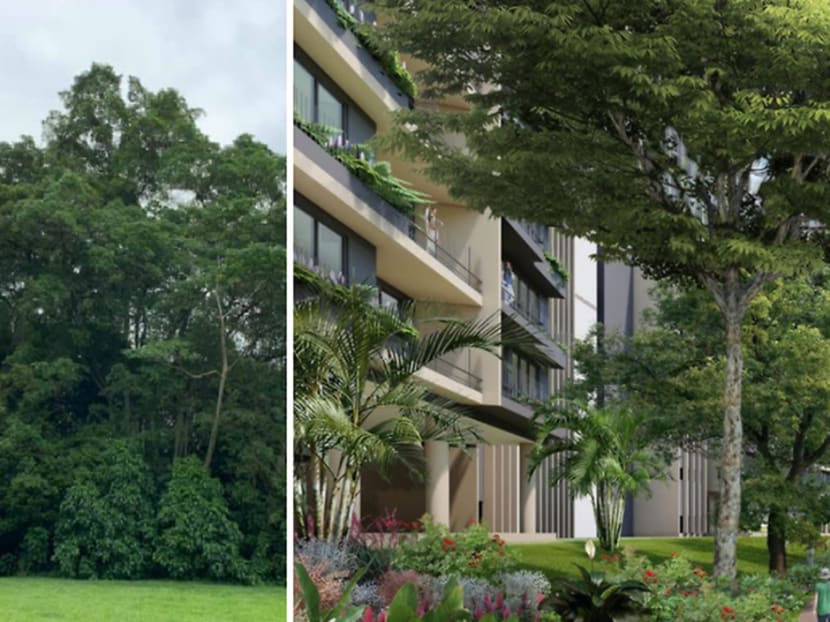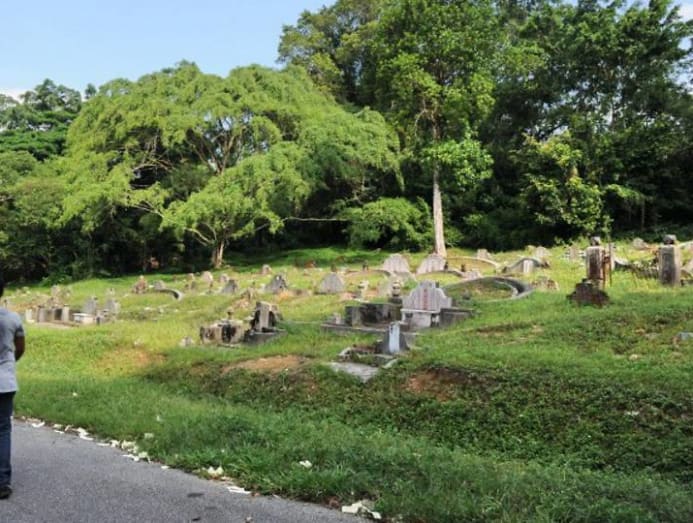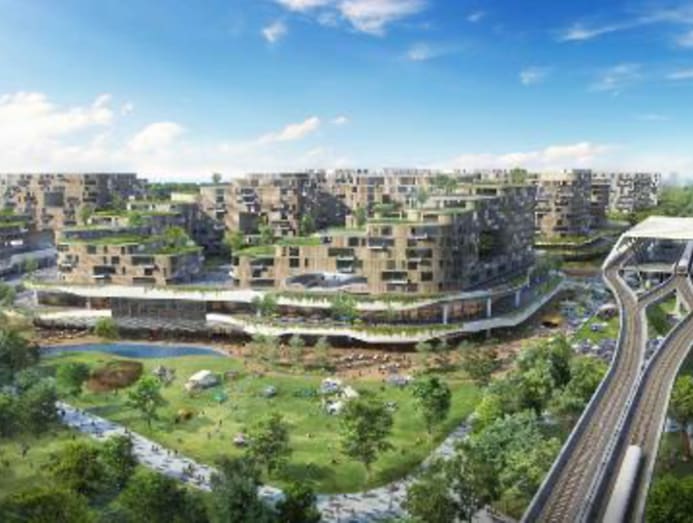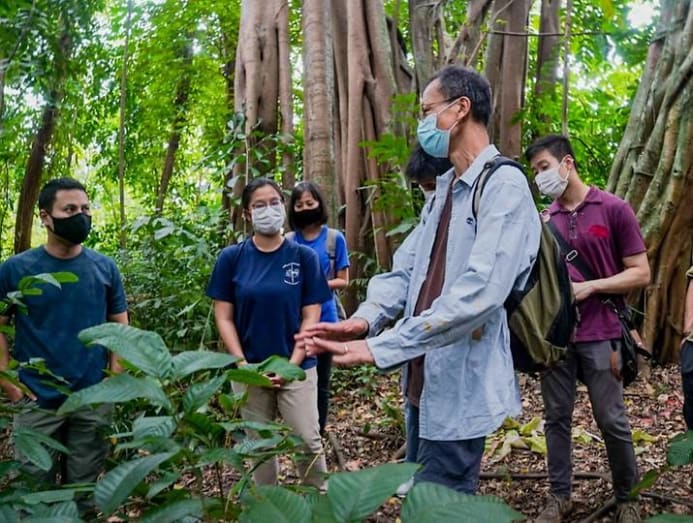commentary Commentary
Commentary: Saving Dover Forest and the plight of the Singapore urban planner
Apart from incorporation consultation on conservation at the planning stage, Singapore’s urban planning should also engage stakeholders at the implementation stage, says IPS’ Woo Jun Jie.

Composite picture of Dover forest and artist's impression of future Ulu Pandan estate. (Photos: Desmond Lee/Facebook and HDB)
SINGAPORE: The ongoing public debates over Dover Forest represents growing public interest in nature conservation and the protection of biodiversity.
It also reveals the uncomfortable fact that in land-scarce Singapore, planning for the needs of the population and economy can come with potential trade-offs.
But as Minister for National Development Desmond Lee underscored in a Facebook post on Thursday (Jan 28) while visiting Ulu Pandan with nature groups, development and conservation need not necessarily be a zero-sum game.
The larger question may be this: Can policymakers and conservationists find a practical approach in striking a middle ground that allows Singapore to retain its biodiversity even as it plans for the needs of its future generations?
Perhaps more concretely, at which part of the planning process can the views of nature groups and even members of the public be taken onboard?
READ: IN FOCUS: How urbanised Singapore is learning to live with its wildlife
THE DOVER FOREST CONUNDRUM
Calls to conserve Dover Forest among members of the public and other nature groups, including Singapore Youth Voices for Biodiversity and LepakInSG, emerged after the Nature Society of Singapore released a proposal suggesting Dover Forest could be turned into a “nature park” in response to plans to develop a part of the forest into a 33ha housing estate. A Change.org petition has been set up to save the forest.
These sentiments have not gone unnoticed among Singapore’s policymakers.
Two Members of Parliament have indicated that they will raise the issue in parliament, with Holland-Bukit Timah GRC MP Christopher de Souza filing an adjournment motion on the preservation of Dover Forest and Government Parliamentary Committee for Sustainability and the Environment chairman Louis Ng stating he will raise the issue in Parliament.
This is not the first time public debate has been stimulated by the impending redevelopment of a green space.

In 2012, plans to construct a new road through Bukit Brown Cemetery led to public outcry among conservation groups. This prompted then-Minister for National Development Tan Chuan-Jin to lead a public engagement exercise with these groups.
Similar concerns were raised late last year, with members of the public raising a petition to protect Clementi Forest.
Mr Lee has since stated that while Clementi Forest remains classified for residential use, there are no immediate plans to develop the site for housing.
SINGAPORE’S URBAN PLANNING PROCESS
Singapore takes a long-term approach to urban planning and land-use policy. At the heart of Singapore’s urban planning process is the Urban Redevelopment Authority (URA), with other relevant departments and agencies such as the Ministry of National Development, Housing and Development Board, and Singapore Land Authority playing crucial roles.
There are two main components to this planning process. The first stage involves the drafting of a Concept Plan that guides Singapore’s development over the next 40 to 50 years.
The Concept Plan lays out the broad strokes of land allocation, taking into account the needs of Singapore’s population and economy.
This is followed by the drafting of a Master Plan, which translates the Concept Plan’s broad goals and objectives into more detailed implementation plans for the next 10 to 15 years. It is at this stage that permissible land use and densities are specified.
READ: Commentary: Save forests or build 4-rooms? It’s not a zero-sum game
Both the Concept Plan and Master Plan are reviewed periodically. It is during these periodic reviews and revisions to the Concept Plan and Master Plan that public engagement and consultation is carried out by the URA.
For instance, the Master Plan review process of 2019 saw the URA reach out to a range of stakeholders from local communities, professionals, grassroots organisations, and academic institutions. This involved engagement sessions, design workshops, and a Draft Master Plan 2019 Exhibition at the URA Centre.
However, both the Concept Plan and Master Plan are long-term planning instruments used to plan for developments only implemented decades later.
READ: The Dover Forest debate: Can nature and development co-exist in urbanised Singapore?
For instance, Dover Forest was initially zoned for residential development in 2003. It was only more recently, with the impending launch of Ulu Pandan Build-To-Order (BTO) flats, that the issue surfaced on the public agenda.
While it may not be possible at this stage to go back to the master planning stage and rezone an area already slated for residential development, there may be scope still to incorporate this public demand for conservation and green spaces for future developments.

Engaging conservation experts and green groups over the design of environmental baseline studies or environmental impact assessments that assess the implications of construction near nature reserves could be helpful.
Some conservationists point out that in the last 18 years, Dover Forest has flourished, making it home to a diverse group of wildlife. And over the years, many have enjoyed this slice of green – hence the keen interest in conserving it.
Aside from conserving Dover Forest, the NSS had also suggested several alternative sites for residential development including unused land near One-North and a degazetted golf course at Choa Chu Kang. However, these may not possess the land area needed for effective town planning.
Singapore takes an integrative approach to town planning that incorporates basic amenities such as markets, polyclinics, schools, public transport nodes, and green spaces in to every residential estate. This ensures that towns are self-sufficient and that residents have easy access to basic amenities.
READ: Commentary: When Singapore homes become workspaces – huge changes in the house and beyond
More importantly, this approach to town planning requires larger plots of land to accommodate both residential apartment blocks and basic amenities sustaining urban life in these estates.
Situating apartment blocks in smaller plots of land without factoring in demand for accessible amenities can give rise to a hodge-podge approach to urban planning, adding significant strains to public infrastructure in existing towns.
As newer HDB estates such as Tengah and Bidadari have shown, the design of residential estates and new towns can be adjusted to allow for the incorporation of more green spaces, or even green zones where wildlife can retreat safely into. The inclusion of such green spaces can also benefit residents immensely.
As Executive Director of the Centre for Liveable Cities Khoo Teng Chye has recently noted, a post-COVID-19 approach to urban design must involve the creation of more green spaces.
We have also come to see how such green spaces contribute to the well-being of residents, particularly during the circuit breaker early last year.
Listen to conservation scientist Koh Lian Pin discuss why conserving forests and mangroves is critical to our fight against climate change on CNA's The Climate Conservation podcast:
CO-PLANNING A CITY IN NATURE
Singapore’s approach to designing and integrating green spaces into the urban landscape has evolved significantly over the years.
From its early conception of being a garden city to its current approach of building a “city in nature”, there is a deepening appreciation of how green spaces and biodiversity can contribute to urban sustainability and citizen well-being.
The next step will be to find more ways of incorporating public feedback and suggestions into the planning process, without compromising on policy efficiency or the broader housing and developmental needs of the population.
READ: Commentary: Let Singapore’s green spaces grow wild
From a policy perspective, planners and policymakers can continue to solicit public feedback at key stages of the planning process, such as during revisions to the Master Plan or Concept Plan.
More windows for public engagement can also be institutionalised during the planning and implementation process, especially as it pertains to the actual design process of towns and housing estates.
For instance, planners can present several possible designs for future towns and HDB estates, each with its own ratio of built-up area to green spaces, to the public. In the same way residents’ preferences for paint schemes have been incorporated, public feedback of different urban designs can then be factored in to the ultimate urban design process.

For their part, conservationists and members of the public should play an active role in engaging with policymakers as well. This means keeping track of the URA’s consultative processes and channels, and providing constructive feedback as these periodically open up.
There is therefore a need for an active citizenry, as much as there is one for a consultative government. The two should go hand-in-hand when it comes to urban planning.
Having said that, some caution is also needed when considering the needs of current stakeholders.
READ: Commentary: The truth behind returning wildlife is less feel-good than you think
While future homeowners do not have a voice at this stage, given that future residential developments such as Ulu Pandan estate have yet to be put up for sale and balloting, no one wants housing ballot queues to get longer.
The URA must navigate carefully, balancing the needs of conservationists and homeowners, as well as current and future stakeholders in any given plot of land. In any case, taking a more consultative approach can clarify these needs and hopefully help achieve broad public consensus.
More than simply a matter of responding to public needs, such engagement of the public in the planning process can foster a greater sense of stakeholdership and ownership among citizens.
READ: Commentary: How do we decide which buildings are worth conserving?
One instructive example is the plan to create a 6km-long green connection from the Singapore Botanic Gardens to Singapore River, unveiled after extensive public consultation by the URA and National Parks Board (NParks).
According to the URA, more than 1,500 members of the public had shared their feedback, calling for more green spaces and family-friendly facilities along Orchard Road.
It is through public consultation that the URA can assess the full extent of public demand for green spaces. It is also through public consultation that members of the public can give voice to their needs, and hopefully help shape the urban environment.
All this should be good news for URA’s urban planners who may find renewed purpose in engaging Singaporeans and securing their buy-in in building the homes of our collective dreams.
Listen to the author, Nature Society of Singapore and a conservation researcher break down what makes Dover Forest so special and how conservation and urban planning can go hand-in-hand on CNA's Heart of the Matter podcast:
Dr Woo Jun Jie is Senior Research Fellow at the Institute of Policy Studies, National University of Singapore.





